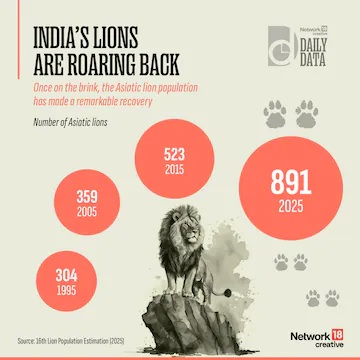Asiatic Lion Census 2025

- 22 May 2025
In News:
According to the 16th Asiatic Lion Census (2025) conducted by the Gujarat Forest Department, the Asiatic lion (Panthera leopersica) population has grown from 674 in 2020 to 891 in 2025, marking a 32.2% increase in five years.
Key Highlights:
- Core Areas (Protected Forests & Sanctuaries): 384 lions
- Non-Forest Areas: 507 lions (up from 340 in 2020)
- 44.22% of the total population now lives outside traditional protected zones.
- Gir National Park, along with Gir Wildlife Sanctuary and Pania Wildlife Sanctuary, holds 394 lions—the core population.
- Amreli district leads with 257 lions, while Mitiyala Wildlife Sanctuary has seen its count double to 32.
- Barda Wildlife Sanctuary near Porbandar recorded 17 lions, marking a population return since 1879.
- New satellite populations identified near Jetpur and Babra-Jasdan.
- Adult Females: 330 recorded—a 27% increase since 2020, indicating strong reproductive potential.
Census Methodology
The 2025 census employed direct beat verification, a statistically rigorous method:
- The landscape was divided into zones and sub-zones.
- Personnel included officials, enumerators, supervisors, and volunteers.
- Unlike the tiger census (which spans 2 years), the lion census was completed in just 3 days.
Project Lion (Launched in 2020)
Aimed at ensuring the long-term conservation of Asiatic lions, Project Lion focuses on:
- Habitat restoration
- Strengthening the prey base
- Human-wildlife conflict mitigation
- Monitoring via advanced technology, including:
- Radio-collars
- Camera traps
- Global Positioning System (GPS) tracking
- GIS-based real-time surveillance
- AI-driven tools likeSIMBA, e-GujForest, andAlert Generation System
- Automated sensor grids (magnetic, motion, infrared)
Habitat and Legal Status
- Natural Habitat: Grasslands, open woodlands, savannas, and scrublands.
- Main Range: Gir Forests in Gujarat; Barda Wildlife Sanctuary emerging as a second habitat.
- Legal Protection:
- Schedule I and IV of the Wildlife (Protection) Act, 1972
- Appendix I of CITES
- IUCN Status: Vulnerable
Distinctive Traits
- Smaller in size compared to African lions.
- Males have a moderate mane allowing visible ears.
- A distinct belly fold—rare in African lions.
- No fixed breeding season.
Global Conservation Context
India is a founding member of the International Big Cats Alliance (IBCA), launched in 2023 to enhance global cooperation on big cat conservation, including lions.
Additionally, the IUCN’s Green Status of Species (2025) introduced a recovery-based conservation framework. Lions are currently classified as "Largely Depleted", highlighting the need for sustained and collaborative conservation actions.
